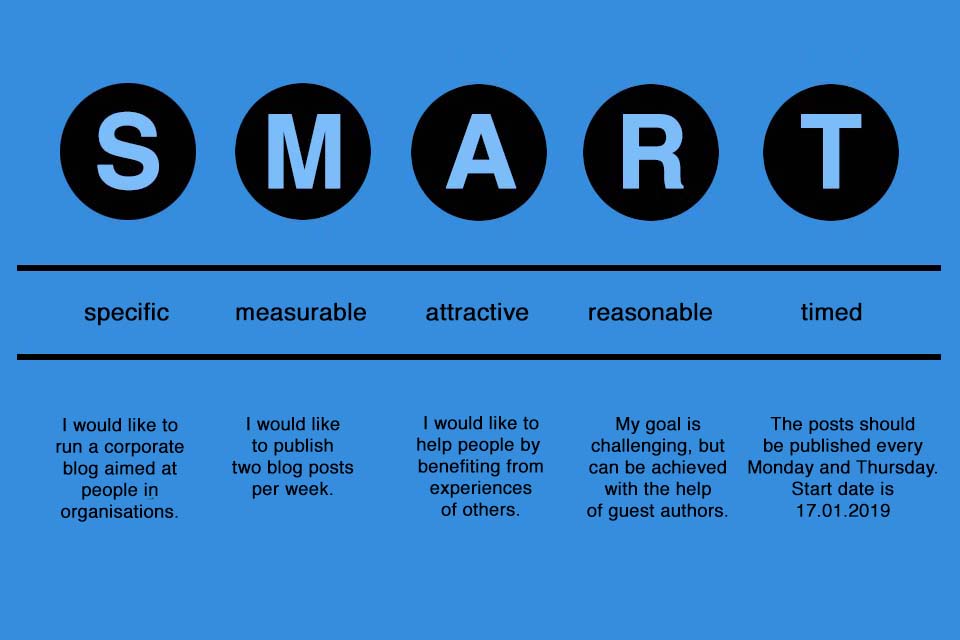What is the SMART Formula?
Smartpedia: The SMART formula is an aid for phrasing objectives. These should be specific, measurable, attractive, reasonable and timed.
SMART Formula – the clever way to formulate objectives
“You should formulate your objective in a smart way” is an appeal when it comes to phrasing objectives. Smart in the sense of clever and clever in the sense of the SMART formula. SMART is an acronym and stands for
- Specific,
- Measurable,
- Attractive (or Attainable or Actionable)
- Reasonable (or Realistic or Relevant),
- Timed (or Time-bound).
An objective describes a state in the future which is different from the present state and is desirable. But what is desirable? The answer to this question is individual: it differs from person to person, from team to team and from organisation to organisation. The SMART Formula helps to formulate goals and provides a basis for assessing the achievement of goals.
Examples of SMART objectives
“We want to generate more sales and increase profits.” Or: “We want to have the new update rolled out company-wide as quickly as possible.” Or: “I want to lose weight and exercise more often.” People often formulate such objectives. What do these examples have in common? They are imprecise. What does “more sales”, “as quickly as possible” or “do exercise more often” mean? But not only are the objectives imprecise, they cannot be measured, they are not timed, and whether they are attainable or relevant cannot be recognised.
Below are some examples of the SMART formula:
- From “I want to lose weight and exercise more often” to “I want to regain my feel-good weight. Therefore, from now on I will go jogging twice a week – always on Mondays and Thursdays – for 5 km each, in order to reduce my weight by 5 kg from 85 kg to 80 kg over the next 3 months”.
- From “We want to generate more sales and increase profits” to “In 2021, we want to increase sales from 1.5 million Euro to 2 million Euro and increase profits to 200,000 Euro before taxes while maintaining the same return on sales of 10%”.
- From “We want to have the new update rolled out company-wide as soon as possible” to: “By 31 October 2020, we want to have the new update of X installed and tested on all workstations in department Y, so that the smooth workflow is ensured on 1 November 2020”.
The SMART Formula in detail
Specific, measurable, attractive, realistic and timed – these are the 5 elements of SMART target setting. But what does that mean in detail? Why is it important to formulate objectives as specifically and measurably as possible? Why do they have to be attractive and realistic? And why is scheduling important?
S as specific
Objectives must be formulated clearly and precisely. The more concrete and clear the better. The specific formulation is the basis for measurability, it develops – provided it is realistic – a motivating effect on the persons concerned and avoids misunderstanding among several parties involved. “We want to increase turnover (from X to Y in Z)”. Not market share, not profit, not customer satisfaction, but turnover.
M as measurable
Objectives must be measurable. Without measurability, the achievement of objectives cannot be monitored. And without verification, the formulation makes little sense. “We want to increase sales from X to Y (in Z).” It is easy to determine whether, at the end of Z, sales have reached the target value of Y.
A as attractive
Objectives must be attractive. Attractive from the point of view of the people who consider the objective desirable. Only if it is desirable can it have a motivating effect. If it is not desirable, it does not justify the effort and expense required to achieve the goal.
R as reasonable
Objectives must be reasonable. Do you want to become the fastest person in the world and run 100 m in 7 seconds? Whoever sets such a goal will not achieve it. Objectives must be an incentive, achievable through effort and commitment. Without realistic formulation they are useless and not motivating.
T as timed
Objectives must be scheduled. A deadline provides clarity. It determines from when or until when something should be achieved. If it is a concrete time span or an exact date, it is specific and creates the basis for measurability (“We want to increase sales from X to Y in Z.”). At the same time it is also essential for a reasonable wording of objectives (to lose 5 kg in 3 hours is not realistic, but in 3 months it probably is).
Here you can find one of the already mentioned examples of the SMART formula broken down by the 5 elements:
“I want to regain my feel-good weight. Therefore, from now on I will go jogging twice a week – always on Mondays and Thursdays – for 5 km each to reduce my weight by 5 kg from 85 kg to 80 kg in the next 3 months”.
- specific: weight loss
- measurable: 5 kg weight reduction from 85 kg to 80 kg
- attractive: feel-good weight 80 kg
- reasonable: 5 kg weight reduction in 3 months
- timed: 3 months
Interestingly, some more information can be gleaned from such an objective formulation: the person wants to jog and not cycle (specific), he or she wants to jog 5 km twice a week (both frequency and distance are measurable and probably reasonable), and he or she wants to become active every Monday and Thursday from now on (timed). In short: this is a smart objective wording.
Advantages of the SMART Formula
The SMART formula offers some clear advantages:
- As an acronym it is easy to remember and easy to apply.
- It is suitable for both strategic and operational objectives or for long-term, medium-term and short-term goals.
- It creates clarity, it offers orientation and promotes a common understanding among those involved.
- It promotes the motivation to achieve a goal at the defined time or within the time frame, provided that it is formulated in an attractive and reasonable way. On the other hand, a lack of motivation can be recognised when this has not been achieved.
Disadvantages of the SMART Formula
There are some “natural” limitations or disadvantages of the SMART formula:
- Its suitability for qualitative objectives is limited, as they are often difficult to quantify.
- It does not provide support for complementary, competing or indifferent objectives.
- It emphasises realism in the formulation of objectives, and thus an evolution and pragmatism rather than reaching for the stars.
- It helps in the formulation of objectives, but not in the definition of goals. For example, attractive and reasonable objectives can contradict each other. SMART offers no help here.
SMART Formula or SMART Method?
The SMART formula is often referred to as the SMART method. For many people it is simply an alternative name, but others argue that SMART is not a method. SMART is an aid, but it does not say HOW something works and is therefore not a method.
How do team members find common objectives? How are conflicting goals recognised (e.g. the goal diagram is suitable here) and resolved? How can it be determined what is attractive and how reasonable should objectives be formulated in order to have a motivating effect? Or how can qualitative objectives be formulated? How can complementary or indifferent objectives be described? How can deviations from goals be corrected? SMART does not answer all these questions and many more and therefore it is “only” a formula and not a method.
Alternatively, the term SMART model is sometimes used. However, since a model is a simplified representation of reality, this term is not applicable. Or do you see it differently?
Tips for SMART objectives
Here are some tips for using the SMART formula:
- Ego-messages or formulations strengthen the effect: “I want …”. Or: “We, the department A, will …”
- Write down the objective. Print it out and hang it on the wall so that it is always visible and serves as a guide.
- Obtain the agreement and commitment of all those involved. For example, have the printout on the wall signed by all those involved.
- If it is sensible, possible and useful, break the objective down into smaller units. If you want to lose 5 kg in 3 months, you should have lost about 1.5 kg after one month.
- Try to find a balance between short-term and long-term goals. Short-term goals that overstrain are just as unhelpful as long-term goals that understrain.
- Ideally, a clever objective meets the 5 elements of SMART. In reality, however, it can also happen that it is not really clear how reasonable a objective can be formulated. In the classic sense of a project or product development, this would mean that a goal should rather be formulated a little too large. In alternative scenarios, which are characterised by self-determination and personal responsibility, this would not have to be the case.
- While it makes sense to formulate smart goals, the targets should not be too specific. For instance: Someone who wants to buy a house with 12 rooms and a swimming pool with a length of 27 metres would fail if the pool was “only” 25 metres long.
- Ideally, concrete specifications can be determined or measured as easily as possible. As the complexity of a method for measuring target achievement increases, it may not be worth the effort.
- A balance between attractive and realistic targets is difficult to achieve in practice. What seems attractive and realistic on the one hand may be less realistic than expected after a short while on the other hand.
- Gather your own experiences and reflect on them for yourself or together in a team.
And last but not least: even with smart formulations, conflicting objectives are not uncommon. The challenge lies in dealing with them.
Impulse to discuss
Notes:
You can find a German video here: SMART Ziele.
If you like the article or would like to discuss it, please feel free to share it in your network. And if you have any comments, please do not hesitate to send us a message.
And here you can find additional information from our t2informatik Blog:



